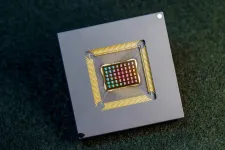(Press-News.org) One day Long Covid in children could be objectively diagnosed with a blood test, thanks to the help of Artificial Intelligence (AI). In fact, a study by the Università Cattolica del Sacro Cuore, Rome campus - Fondazione Policlinico Universitario Agostino Gemelli IRCCS and the Ospedale Pediatrico Bambino Gesù IRCCS, has highlighted the molecular signature of Long Covid in plasma in paediatric age and used an AI tool capable of making the diagnosis based on the results of the blood sample, with 93% accuracy.
The study was published in the journal ‘Pediatric Research’, by Nature Group, and was led by Dr. Danilo Buonsenso, researcher in general and specialist paediatrics at the Faculty of Medicine and Surgery of the Catholic University and paediatrician at the Pediatric Infectious Diseases Operative Unit of the Fondazione Policlinico Gemelli IRCCS, together with Dr. Nicola Cotugno, at the Complex Operative Unit of Clinical Immunology and Vaccinology of the Bambino Gesù IRCCS Paediatric Hospital.
The study involved, among others, Dr. Piero Valentini, researcher in General and Specialist Paediatrics at the Faculty of Medicine and Surgery of the Catholic University and director of the Paediatric Infectious Diseases Operative Unit of the Fondazione Policlinico Gemelli IRCCS, and Dr. Paolo Palma, head of the Complex Operative Unit of Clinical Immunology and Vaccinology of the Bambino Gesù Children's Hospital IRCCS.
BACKGROUND
Long Covid affects on average 0.5% of pediatric patients exposed to SARS-CoV-2. This condition, also known as Post COVID or Post-Acute Sequelae of SARS-CoV-2, is characterized by the persistence of signs and symptoms for at least 8-12 weeks, symptoms not present before the viral infection, with a negative impact on daily life. Long COVID affects patients of almost all age groups, and among pediatric patients those older than 10 years seem to be most affected, regardless of the severity of the initial infection.
In adults, the Long COVID ‘sign’ was found in the blood of adults, but a similar finding in the paediatric population was lacking.
THE STUDY
The experts analyzed the blood of 112 young people aged 0-19 years, of whom 34 had a clinical diagnosis of Long COVID, 32 had the active infection at the time of the study, 27 had Multisystem Inflammatory Syndrome (MIS-C, a severe hyper-inflammatory reaction that almost always requires intensive care) and 19 healthy control peers.
The experts performed an analysis of the blood protein component (proteomics) and saw that, compared to the control groups, the pediatric Long COVID was characterized by a higher presence in plasma of the pro-inflammatory and pro-angiogenic chemokine sets CXCL11, CXCL1, CXCL5, CXCL6, CXCL8, TNFSF11, OSM, STAMBP1a. An artificial intelligence model based on proteomic profiling was able to identify long Covid with an accuracy of 0.93, a specificity of 0.86 and a sensitivity of 0.97.
CONCLUSIONS
Long Covid in pediatric patients also presents a distinct protein signature in plasma, characterized by increased inflammation in general and at the level of blood vessel walls (endothelia), as already seen in adults. The discovery could lead to the development of a simple routine diagnostic test based on a blood sample, allowing timely and complete care of the pediatric patient with Long Covid.
‘The immunological data produced in this study provide the evidence needed to identify therapeutic targets to be tested in efficacy and safety studies in pediatric Long Covid,’ Dr Cotugno of the Bambino Gesù Children's Hospital explains.
‘This work demonstrates incontrovertibly that Long Covid, also in pediatric age, is an organic immune-mediated disease, for which new funding is needed to study the best therapeutic approaches,’ Dr Buonsenso concludes.
END
Long COVID, Italian scientists discovered the molecular ‘fingerprint’ of the condition in children's blood
2025-01-24
ELSE PRESS RELEASES FROM THIS DATE:
Battery-powered electric vehicles now match petrol and diesel counterparts for longevity
2025-01-24
Battery-powered electric vehicles are now more reliable and can match the lifespans of traditional cars and vans with petrol and diesel engines - marking a pivotal moment in the drive towards sustainable transportation, a new study reveals.
Researchers used nearly 300 million UK Ministry of Transport (MOT) test records charting the ‘health’ of every vehicle on the United Kingdom’s roads between 2005 and 2022 to estimate vehicle longevity and provide a comprehensive analysis of survival rates for different powertrains.
The international research ...
MIT method enables protein labeling of tens of millions of densely packed cells in organ-scale tissues
2025-01-24
A new technology developed at MIT enables scientists to label proteins across millions of individual cells in fully intact 3D tissues with unprecedented speed, uniformity, and versatility. Using the technology, the team was able to richly label whole rodent brains and other large tissue samples in a single day. In their new study in Nature Biotechnology, they also demonstrate that the ability to label proteins with antibodies at the single-cell level across whole brains can reveal insights left hidden by other widely used labeling methods.
Profiling the proteins that cells are making is a staple of studies in biology, neuroscience and related fields because the ...
Calculating error-free more easily with two codes
2025-01-24
Computers also make mistakes. These are usually suppressed by technical measures or detected and corrected during the calculation. In quantum computers, this involves some effort, as no copy can be made of an unknown quantum state. This means that the state cannot be saved multiple times during the calculation and an error cannot be detected by comparing these copies. Inspired by classical computer science, quantum physics has developed a different method in which the quantum information is distributed across several entangled quantum bits and stored redundantly in this ...
Dissolving clusters of cancer cells to prevent metastases
2025-01-24
Certain tumour types do not remain at their point of origin but spread throughout the body and form metastases. This is because the primary tumour continuously releases cancer cells into the blood. These circulating tumour cells (CTCs) can join together into small clusters of up to a dozen cells and settle in other organs. There, the clusters grow into larger tumours, known as metastases. Metastatic tumours are still a major medical problem: every year, around seven million people worldwide die from them.
One example of such a spreading tumour is breast cancer. As soon ...
A therapeutic HPV vaccine could eliminate precancerous cervical lesions
2025-01-24
PHILADELPHIA – A therapeutic vaccine targeting human papillomavirus type 16 (HPV16) induced regression in high-grade precancerous cervical lesions, according to the results from a phase II clinical trial published in Clinical Cancer Research, a journal of the American Association for Cancer Research.
“Nearly all premalignant cervical lesions and cervical cancers are caused by HPV infection, with HPV16 implicated in the majority of cases,” said Refika Yigit, MD, principal investigator and oncological gynecologist at University Medical Centre Groningen in the ...
Myth busted: Healthy habits take longer than 21 days to set in
2025-01-24
We’re nearly one month into 2025, but if you’re struggling to hold onto your New Year’s resolution, stay strong, as University of South Australia research shows that forming a healthy habit can take longer than you expect.
In the first systematic review of its kind, UniSA researchers found that new habits can begin forming within about two months (median of 59–66 days) but can take up to 335 days to establish.
It’s an important finding that could inform health interventions to ...
Development of next-generation one-component epoxy with high-temperature stability and flame retardancy
2025-01-24
Two-component epoxies, which require mixing resin and curing agent before use, often suffer from issues such as mixing ratio errors, limited working times, and inconsistent curing. Additionally, they must be used immediately after mixing, leading to wasted residue. To address these challenges, one-component epoxies have gained attention. One-component epoxies come pre-mixed, making them easy to use, reducing processing time, and ensuring consistent quality without mixing. In particular, using latent curing agents allows curing to be triggered only under specific conditions (e.g., heat or UV exposure), significantly improving storage stability. However, ...
Scaling up neuromorphic computing for more efficient and effective AI everywhere and anytime
2025-01-24
Neuromorphic computing—a field that applies principles of neuroscience to computing systems to mimic the brain’s function and structure—needs to scale up if it is to effectively compete with current computing methods. In a review published Jan. 22 in the journal Nature, 23 researchers, including two from the University of California San Diego, present a detailed roadmap of what needs to happen to reach that goal. The article offers a new and practical perspective toward approaching the cognitive capacity of the human brain with comparable form factor and power consumption.
“We ...
Make it worth Weyl: engineering the first semimetallic Weyl quantum crystal
2025-01-24
An international team of researchers led by the Strong Correlation Quantum Transport Laboratory of the RIKEN Center for Emergent Matter Science (CEMS) has demonstrated, in a world’s first, an ideal Weyl semimetal, marking a breakthrough in a decade-old problem of quantum materials.
Weyl fermions arise as collective quantum excitations of electrons in crystals. They are predicted to show exotic electromagnetic properties, attracting intense worldwide interest. However, despite the careful study of thousands of crystals, most ...
Exercise improves brain function, possibly reducing dementia risk
2025-01-24
A study led by scientists at Rutgers University-New Brunswick has shown that specialized cells involved in how the body responds to insulin are activated in the brain after exercise, suggesting that physical activity may directly improve brain function.
A study, published in Aging Cell, a journal focused on the biology of aging, indicates that therapies targeting this insulin action may be developed to offset or even prevent dementia progression.
“We believe this work is important because it suggests exercise may work to improve cognition and memory by improving the abilities of insulin to act on the brain,” ...



